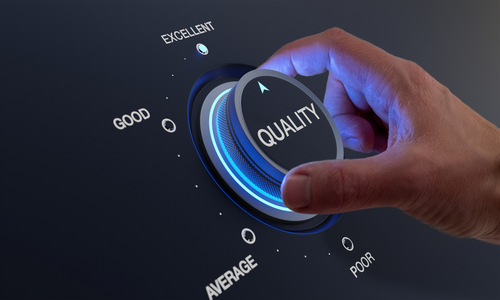The pursuit of quality excellence is a timeless goal, but the methods to achieve it have evolved in recent years. To remain competitive and relevant, organizations must adapt to the changing dynamics of the global economy, technology, and customer expectations. This article explores the concept of achieving quality excellence in the 21st century. It lists down strategies that can empower organizations to thrive in this era.

Strategies for achieving Quality Excellence
Quality plays a vital role in achieving customer satisfaction. Many organization strive to create products that meet specific needs and expectations of consumers. Quality Excellence drives the internal departments of organizations to be the best among their competitors. Check out few strategies followed across various industries to achieve quality excellence.
Quality-centric Culture
Quality excellence begins with a cultural shift within an organization. A quality-centric culture is one where employees understand the importance of quality. They aim at delivering products and services that exceed customer expectations. To cultivate such a culture, organizations should:
- Empower employees: Encourage employees to take ownership of the quality of their work. Empower them to make decisions that prioritize quality, and create a safe environment for raising quality concerns.
- Continuous learning: Promote continuous learning and development. Quality standards and best practices evolve, and employees need to stay updated with the latest techniques and tools.
- Leadership: Leaders should set the standard by demonstrating a commitment to quality in their own work and decision-making. This helps build trust and encourages others to follow suit.
Data-driven Decision Making and Quality Excellence
In this age, data is an invaluable asset of modern organizations. Quality excellence is no exception. Leveraging data to make informed decisions can significantly improve an organization’s quality management processes. To do this effectively:
- Implement quality metrics: Define key performance indicators (KPIs) and use them to track the quality of products or services. These metrics provide actionable insights and enable timely interventions.
- Data analytics: Utilize data analytics to identify trends and opportunities for improvement. Advanced analytics tools can detect hidden quality issues and improve decision-making.
- Consumer feedback: Gather and analyze customer feedback to identify areas for improvement. Customer-centric data is invaluable in shaping an organization’s quality strategies.
Agile and Lean
The 21st century has seen a surge in the adoption of agile and lean methodologies in various industries. These methodologies focus on efficiency, flexibility, and adaptability. Incorporating agile and lean principles into quality management can be transformative:
- Iterative development: Break down projects into smaller, manageable phases. This approach facilitates regular evaluation and adaptation that reduces the risk of long-term quality issues.
- Waste reduction: Lean principles emphasize eliminating waste in processes. Streamlining operations and reducing unnecessary steps can enhance quality and reduce costs in organizations.
- Cross-functional teams: Create cross-functional teams that collaborate on quality improvement projects. This approach promotes diverse perspectives and expertise.
Technology Integration and Quality Excellence
Organizations that embrace technology can gain a competitive edge in achieving quality excellence. Key strategies in this area include:
- Automation: Implement automation to reduce human error and improve consistency. Robotic Process Automation (RPA) can be used to perform repetitive tasks with high precision.
- Software: Invest in quality management software that can streamline processes, centralize data, and provide real-time visibility into quality metrics.
- IoT and Big Data: In industries like manufacturing, the IoT and big data analytics help in monitoring and improving product quality in real-time.
Supply Chain Management
Supply chains are now increasingly complex and globalized. Achieving quality excellence now involves managing not only internal processes but also those of suppliers and partners. Key strategies include:
- Supplier collaboration: Collaborate with suppliers to establish and maintain stringent quality standards. This includes regular audits, performance evaluations, and shared quality goals.
- Risk mitigation: Identify and mitigate risks in the supply chain that could impact the quality of products or services. This includes contingency planning and diversifying suppliers when necessary.
- Traceability: Implement traceability systems to track the source and journey of materials and components. This enhances transparency and accountability in the supply chain.
Regulatory Compliance and Quality Excellence
These days, regulatory standards and compliance requirements are stringent in many industries. Organizations must ensure they meet these standards while pursuing quality excellence. Strategies for this include:
- Compliance monitoring: Develop processes and systems to continually monitor and assess compliance with relevant regulations. Automated compliance management tools can be invaluable.
- Proactive compliance: Instead of treating compliance as a burden, use it as an opportunity to enhance quality. Building quality into compliance processes can lead to long-term benefits.
- Continuous improvement: Regulatory requirements are not static. Organizations should be prepared to adapt and improve their processes to meet evolving standards.
Environmental Responsibility
In the 21st century, sustainability and environmental responsibility are on the forefront of quality excellence. Customers increasingly expect products and services that are not only high-quality but also environmentally friendly. Strategies in this area include:
- Green practices: Implement eco-friendly practices in product design, manufacturing, and packaging. This not only aligns with customer expectations but can also lead to cost savings.
- Circular economy: Embrace the principles of a circular economy by reusing, recycling, and reducing waste. This approach not only benefits the environment but can also open new business opportunities.
- Transparency: Communicate openly about sustainability efforts, enabling customers to make informed choices and building trust.
Employee Well-being and Quality Excellence
Quality excellence is closely tied to the well-being and engagement of employees. Happy and engaged employees are more likely to produce high-quality work. Strategies in this area include:
- Work-Life balance: Promote work-life balance to prevent burnout and increase job satisfaction. This can lead to better quality and higher employee retention.
- Training: Invest in training and development programs to help employees build their skills and confidence, which ultimately translates into improved quality.
- Rewards: Recognize and reward employees for their contributions to quality excellence. This can motivate them to continue delivering top-notch work.
Risk Management
The 21st century witnessed a surge in unexpected disruptions, from natural disasters to global pandemics. Organizations need to build resilience and effective risk management into their quality strategies. Key strategies include:
- Scenario planning: Develop scenarios and contingency plans for various potential disruptions. This allows for a more agile response in times of crisis.
- Diversification: Avoid over-reliance on single suppliers, markets, or processes. Diversifying reduces vulnerability to disruptions.
- Technology-enabled resilience: Leverage technology to enhance the resilience of operations, including remote work capabilities and digital collaboration tools.
Customer-centric Approach and Quality Excellence
In the digital age, customers have more choices and higher expectations than ever before. Achieving quality excellence in the 21st century requires a customer-centric approach. Strategies include:
- Personalization: Tailor products and services to individual customer needs and preferences. This requires data analysis and a deep understanding of your customer base.
- Feedback Loop: Create a feedback loop that allows customers to easily provide input, and act on that feedback to continuously improve quality.
- Omnichannel engagement: Engage with customers through multiple channels, including social media, chat, email, and in-person.
Conclusion:
These top strategies have proven to assist organizations in applying quality excellence measures to a great extent. An organization is bound to train its quality managers extensively for reaping the benefits of quality excellence. This has necessitated the need for allowing professionals in QM to undergo Certified Quality Management Professional Training course. A CQM professional plays a vital role in achieving QE by applying recent practices and strategies at hand for the organization rather than non-certified quality managers.



